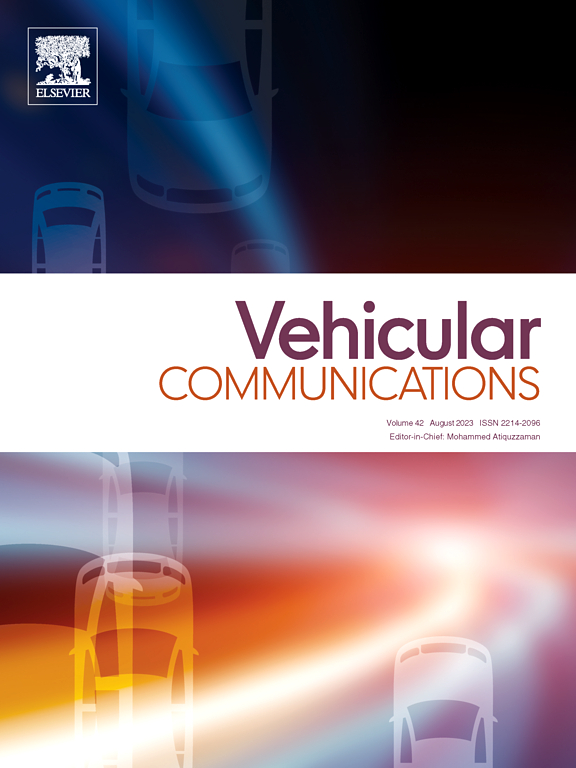Multi-objective resource allocation for UAV-assisted air-ground integrated full-duplex OFDMA networks
IF 6.5
2区 计算机科学
Q1 TELECOMMUNICATIONS
引用次数: 0
Abstract
In multi-UAV-assisted air-ground integrated in-band full-duplex (IBFD) OFDMA networks, both uplink and downlink performances are critical and must be simultaneously considered. This study addresses effective resource allocation in such networks to maximize the total system uplink and downlink rates by jointly optimizing subcarrier assignment and power control. Given the significant trade-off between uplink and downlink transmissions owing to self-interference in IBFD systems and intercell interference, we formulate the resource allocation problem as a multi-objective optimization problem (MOOP), aiming to jointly maximize the uplink and downlink performances. To achieve Pareto optimal solutions, we employ the weighted Tchebycheff technique to transform the MOOP into a single-objective optimization problem (SOOP) and solve it using Successive Convex Approximation (SCA) within a Block Coordinate Descent (BCD) framework. This approach iteratively optimizes the subcarrier assignment and power control and effectively manages the trade-offs between uplink and downlink rates. The proposed method demonstrates the ability to achieve an efficient balance in resource allocation. Simulation results show that our method can obtain Pareto optimal solutions, demonstrating favorable performance trade-offs and fairness under various interference conditions, thereby improving the overall system performance in multi-UAV-assisted air-ground integrated OFDMA networks.
无人机辅助地空一体化全双工OFDMA网络的多目标资源分配
在多无人机辅助的空地带内全双工(IBFD) OFDMA网络中,上行链路和下行链路的性能至关重要,必须同时考虑。本研究通过联合优化子载波分配和功率控制,解决了在此类网络中有效的资源分配问题,以最大限度地提高系统的总上行和下行速率。考虑到IBFD系统的自干扰和小区间干扰导致上下行传输之间存在显著的权衡,我们将资源分配问题制定为多目标优化问题(MOOP),旨在共同最大化上下行性能。为了实现Pareto最优解,我们采用加权Tchebycheff技术将MOOP转化为单目标优化问题(SOOP),并在块坐标下降(BCD)框架内使用连续凸逼近(SCA)进行求解。该方法迭代优化了子载波分配和功率控制,有效地管理了上行和下行速率之间的权衡。所提出的方法证明了实现资源分配有效平衡的能力。仿真结果表明,该方法可以获得Pareto最优解,在各种干扰条件下表现出良好的性能权衡和公平性,从而提高了多无人机辅助地空一体化OFDMA网络的整体系统性能。
本文章由计算机程序翻译,如有差异,请以英文原文为准。
求助全文
约1分钟内获得全文
求助全文
来源期刊

Vehicular Communications
Engineering-Electrical and Electronic Engineering
CiteScore
12.70
自引率
10.40%
发文量
88
审稿时长
62 days
期刊介绍:
Vehicular communications is a growing area of communications between vehicles and including roadside communication infrastructure. Advances in wireless communications are making possible sharing of information through real time communications between vehicles and infrastructure. This has led to applications to increase safety of vehicles and communication between passengers and the Internet. Standardization efforts on vehicular communication are also underway to make vehicular transportation safer, greener and easier.
The aim of the journal is to publish high quality peer–reviewed papers in the area of vehicular communications. The scope encompasses all types of communications involving vehicles, including vehicle–to–vehicle and vehicle–to–infrastructure. The scope includes (but not limited to) the following topics related to vehicular communications:
Vehicle to vehicle and vehicle to infrastructure communications
Channel modelling, modulating and coding
Congestion Control and scalability issues
Protocol design, testing and verification
Routing in vehicular networks
Security issues and countermeasures
Deployment and field testing
Reducing energy consumption and enhancing safety of vehicles
Wireless in–car networks
Data collection and dissemination methods
Mobility and handover issues
Safety and driver assistance applications
UAV
Underwater communications
Autonomous cooperative driving
Social networks
Internet of vehicles
Standardization of protocols.
 求助内容:
求助内容: 应助结果提醒方式:
应助结果提醒方式:


